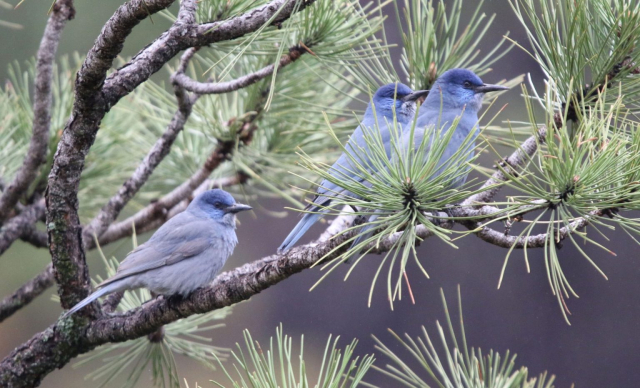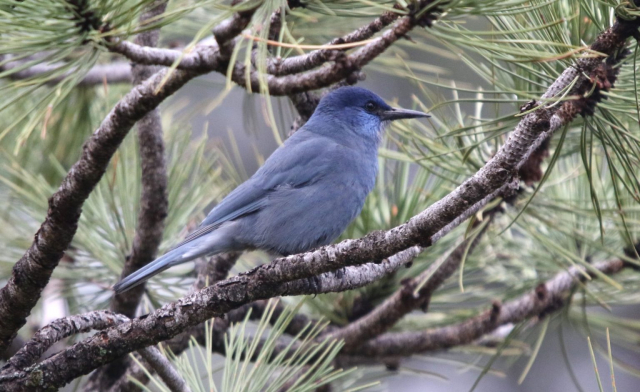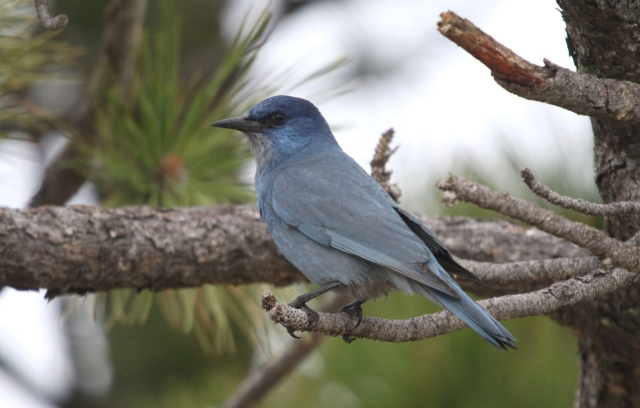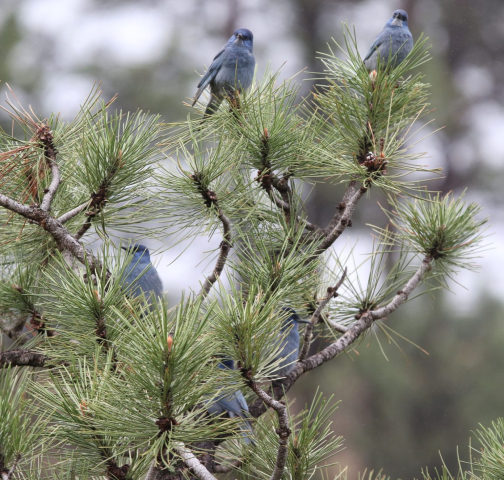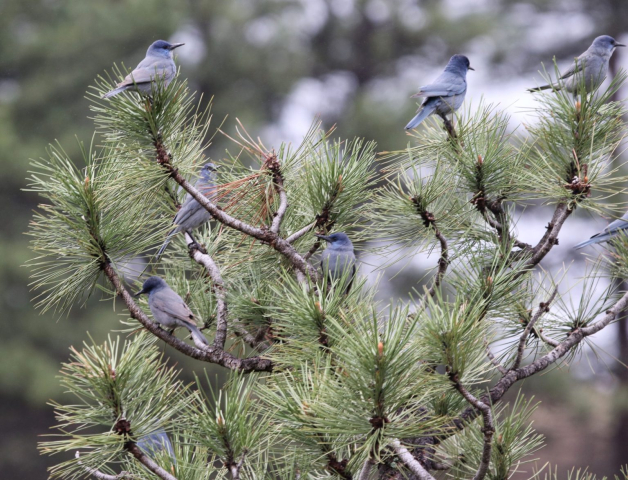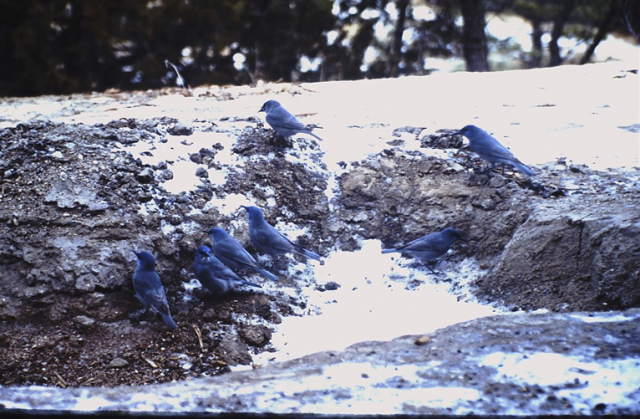Gymnorhinus cyanocephalus cyanocephalus
Status: Rare local regular resident Panhandle. Uncommon regular winter visitor west, rare casual central, accidental east.
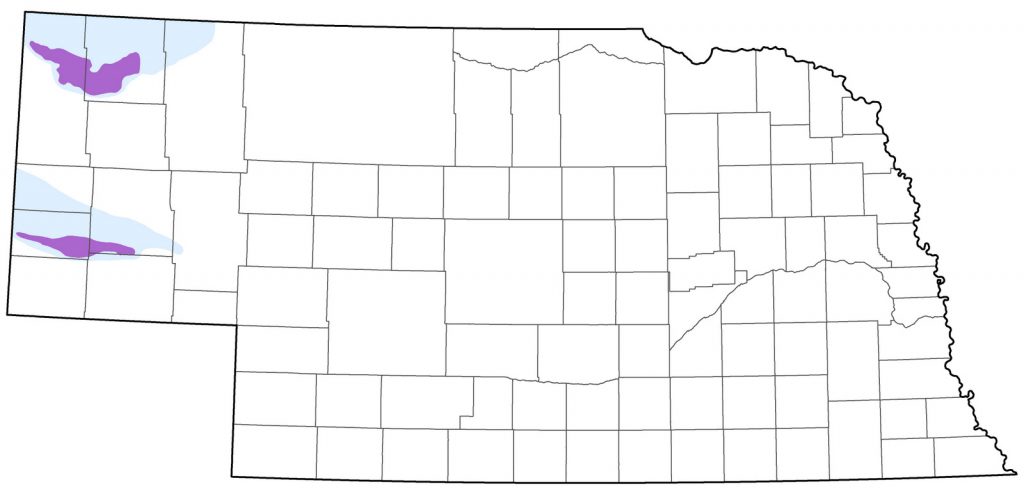
Documentation: Specimen: UNSM ZM7644, 13 Dec 1895 Fort Robinson, Dawes Co.
Taxonomy: No subspecies are recognized (AviList 2025).
Pyle (1997) recognized three weakly-differentiated subspecies: cassini from Oregon to Idaho and south to Nevada and New Mexico, rostratus, of southeast California, and cyanocephalus from Montana to North Dakota, south to northern Colorado, including the South Dakota Black Hills. Phillips (1986) indicated that birds reaching northern and northwestern Nebraska after breeding were of the eastern Rocky Mountain subspecies cyanocephalus.
Resident: The breeding status of this species in Nebraska was discussed by Mollhoff (2000), who pointed out that despite several early assumptions that Pinyon Jay bred in Nebraska (see Comments), “conclusive evidence in the form of an active nest or of non-flying young restricted to the natal site has not been presented.” Mollhoff (2001a) noted that during the First BBA 1984-1989 adults were found feeding young 22 May in Scotts Bluff Co and 29 Apr-9 Jun in Sioux Co but suggested that “Since the young were free-flying and following the flock, however, it could be argued that they might have been hatched at some distance from where they were found.” Thus, Mollhoff (2000) stated that although “There is little doubt that Pinyon Jays have been regular breeders in Nebraska since first reported a century ago”, the first confirmed record was his discovery of a nest with eggs and newly hatched young 11 Jun 1999 in ponderosa pine woodland in East Monroe Canyon, Sioux Co; the young were well grown on 25 Jun and absent on 13 Aug (Mollhoff 2000, 2001b).
Important in understanding movements of this species is its propensity to form permanent flocks that consist primarily of related individuals (Balda and Bateman 1972; Johnson and Balda 2020). According to these authors, fledglings tend to stay with the natal flock for their lifetimes. During the breeding season, breeders separate from the main flock and form a nesting colony nearby. After young are fledged the breeding group re-joins the main group, which then becomes nomadic until the next breeding season, when it returns to the breeding site used in previous years (Johnson and Balda 2020). There are fewer reports in summer than at other seasons (Rosche 1982).
Wayne Mollhoff (personal communication) described the nesting behavior in Nebraska of a Bighorn Escarpment flock: “The Pinyon Jay flocks/colonies each maintain a discrete territory. Somewhere in each territory they have a nesting territory. The Redington flock nested each year in a side canyon about 300 meters wide and 1000 meters long. It took me 3 years of searching their territory to find where they nested. They pick a new site, maybe 20 x 40 meters, to place their nests each year. Each year the flock builds their nests in a cluster and never uses them again. The next year they moved to another site within the canyon and did the same. And again. So it was the same flock/colony involved. The landowner I worked with told me the approximate flock territory (which as I recall covered a good part of a township), and then told me how far it was to the next flock’s territory (10-15 miles). When I asked how he knew that, he told me that he trapped coyotes all over that area for about 30 years.”
Since 1989 the only records of breeding are from the Pine Ridge and the Bighorn Escarpment in Morrill Co. Breeding has not been confirmed in the Wildcat Hills, Scotts Bluff Co; although Mollhoff (2001a) reported adults feeding young 22 May in Scotts Bluff Co he noted these young birds were mobile. It is possible they may have been members of the Bighorn Escarpment flock (see below).
On the Pine Ridge, breeding was confirmed in 1999 when a nest with eggs and newly hatched young was located 11 Jun in ponderosa pine woodland in East Monroe Canyon, Sioux Co; the young were well grown on 25 Jun and absent on 13 Aug (Mollhoff 2000, 2001b). A note in the First BBA 1984-1989 indicated adults were reported feeding young 29 Apr-9 Jun in Sioux Co (Mollhoff 2001a), but Mollhoff (2000) suggested these may have been part of a mobile post-breeding flock. In 2010, 2-3 were located along Corkscrew Road in Sioux Co 16 May in an area they had occupied in 2008; these birds were building a nest, which may have been a second attempt at that date. Adults and mobile young were in Smiley Canyon, Sioux Co 14 Jun 2003, another group of 12 was there 4-7 Jun 2020, 12 were there 26 Jun 2021, and five on 22 May 2023. These flocks may not have nested in the immediate area. Mollhoff (personal communication) mentioned a pair building a nest on the upper White River near Glen, Sioux Co but was unable to check it later, and in West Ash Canyon, Dawes Co adults with fledged young were found but searches did not locate nests. A single was at West Ash Creek, Dawes Co 4 Jul 2021.
Breeding activity on the Bighorn Escarpment is centered on the area around Redington. Mollhoff described breeding behavior of a breeding flock in this area (see above). Rosche (1994) noted that the species “reaches eastern limits” in the Bighorn Escarpment, presumably the area near Redington mentioned by Mollhoff (1999). This site has a consistent history of breeding season sightings. About 10 birds were there Apr and May 1987 (Williams 1987) and flocks of 5-75 birds, including fledged young, were seen with young of the year 16 May 1998 (Mollhoff 1999). Nine empty nests located seven miles southwest of Redington, Morrill Co 14 Apr 2001 were thought to be the remains of a nesting colony there in 1999 or 2000, but 10 nests under construction were found in the same general area 29 Apr 2001 (Mollhoff 2004) and a nest with eggs was found 1 Jun 2001 (Mollhoff 2001b); this same site was occupied by four nests with 4-5 eggs each 17 Apr 2006 (Mollhoff 2006). A feeder regularly used by this species in the Bighorn Escarpment in Morrill Co hosted as many as 139 on 12 Dec 2022, presumably representatives of the Bighorn Escarpment breeding flock.
During the First BBA the species was found in 10 survey blocks, but during the Second BBA period Pinyon Jays were found in only six of those blocks, despite a 30% increase in effort (Mollhoff 2016). Pinyon Jay is a species of significant conservation concern that has declined by as much as 84% since the 1970s (Rosenburg et al 2016). BBS trend analysis shows notable annual declines ranging from 3-6% for Colorado, Wyoming and South Dakota (Sauer et al 2017); trend analyses are not available for Nebraska due to small sample sizes. Pinyon Jay would seem vulnerable to extirpation in Nebraska given range wide and regional declines in numbers and since Nebraska’s populations are small and disjunct. In addition, it has been pointed out by Mollhoff (personal communication) that Nebraska Pinyon Jays survive on an atypical diet for the species, ponderosa pine seeds, which are much smaller than the species’ typical diet of pinyon nuts; this difference may alter the reproductive biology and movements of the species in Nebraska.
- Breeding Phenology:
Nest-building: 29 Apr-16 May
Eggs: 17 Apr-11 Jun (Jun eggs dates are second attempts, Mollhoff 2022)
Nestlings: 11-25 Jun
Fledglings: 29 Apr-14 Jun
Winter: This species is highly gregarious most of the year, and flocks may cover considerable distances in search of food outside of the breeding season (Bent 1946). Large numbers are sometimes seen at feeders in towns, such as the “invasion” in Chadron, Dawes Co in Sep 1985 (Williams 1986), and in Scotts Bluff Co, where 350 were counted on the 18 Dec 1971 Scottsbluff CBC. High CBC counts of 170 were also made at Crawford in 1977 and 1978. Rosche (1982) stated that more are seen in fall, winter, and spring than in summer, and suggested that local populations may be augmented by birds from “presumably further west” (see also Phillips 1986), although there are no banding data to support this. A rancher’s yard northwest of Dalton in Morrill Co has hosted large numbers, likely members of the same flock of related individuals, beginning in 2014 with 84 on 17 Feb and 80 that fall on 1 Nov; the same yard hosted at least 28 from 21 Sep 2020 through 13 Jan 2021, and a remarkable count of 139 on 12 Dec 2022 followed by 85 on 13 Mar 2023. None were reported until in 2024, when 11 were there 29 Sep and 12-13 from 15 Dec 2024 through 3 Jan 2025.
Fall of 2022 saw an influx of Pinyon Jays, beginning with as many as 51 at Smiley Canyon, Sioux Co 27-29 Sep; most sightings were in Oct. Smaller numbers were reported elsewhere on the Pine Ridge: three on 26 Sep and 12 on 12 Oct at Ponderosa WMA, Sioux Co, four at West Ash Creek, Dawes Co 10 Oct, and one at Chadron SP, Dawes Co 13 Oct. Most unexpected were easterly sightings of one in Ogallala, Keith Co 5 Nov and one photographed in an eastern Lincoln Co yard 27-30 Oct (Mike Penry fide Linda Deeds, personal communication).
Pinyon Jays occur irregularly away from and east of the breeding range, mostly in the Platte River Valley, but rarely east of Lincoln Co. In Lincoln Co, Tout (1947) considered it an irregular winter visitor 16 Sep-5 May, and more recently a small flock of five was seen in southeast Lincoln Co 30 Oct 2016, one was photographed there 27-30 Oct 2022, and another was in a North Platte, Lincoln Co yard 29-30 Apr 2023. A localized irruption was noted in the Ogallala area, Keith Co 2002-2003, when one was five miles northeast of Lake McConaughy at a feeder in early Dec 2002, and a group of five were in an Ogallala neighborhood from about 1 Dec 2002 through at least 16 May 2003. A group of seven was in Ogallala 6 Nov 2012, the first there “for several years”.
Elsewhere away from the Pine Ridge or North Platte River Valley, Glandon and Glandon (1934) noted that “a small flock appeared almost every winter.” in Logan Co. A group of 11 which appeared at Wind Springs Ranch in southern Sioux Co 28 Jul 2006 may have dispersed from the Pine Ridge or elsewhere in response to extensive fires there. One was photographed in Chase Co 3 Dec 2002 (Brogie 2003) and a single was at Lake Minatare, Scotts Bluff Co 31 Oct 2023. Three appeared at Oliver Reservoir, Kimball Co 3 Sep 2024.
Reports farther east in or near the Platte River Valley include 40 wintering at Gibbon, Buffalo Co through 11 Apr 1911 (Bates 1918), a single at a Kearney, Buffalo Co feeder during the winter of 1996-97 (Brogie 1998), the same winter one appeared in central Iowa (Crim and Crim 1997). Wintering birds were at Wood River, Hall Co 1915-1916 (Bates 1918). A “small flock of seven or eight” were near Hastings, Adams Co 16 Oct 1934 (Swenk 1935), it was reported near Kenesaw, Adams Co fall 1937 (Brooking 1938), and a specimen, HMM 2517, was collected at Hastings 20 Oct 1926 10 days after Brooking reported one there (Jorgensen 2012). In Polk Co, 8-10 were near Osceola Nov 1930 (Jorgensen 2012). Quite remarkable was a recent report of a single along the north edge of Wagon Train SRA, Lancaster Co 20-24 Feb 2023; it was seen there again 25 Mar 2023.
A flock of 40 wintered 1910-1911 at Red Cloud, Webster Co (Bates 1924) and wintering birds were there 1 Nov 1916 through 21 May 1917 (Bates 1918). At least one was at Bloomington, Franklin Co Oct 1916 (Bates 1918).
In the northeast, “a few” were at Long Pine, Brown Co 9 Aug and 2 Oct 1897 (Bates 1918), a flock estimated at 100 was at Long Pine 18 Oct 1900 (Bates 1918), around 40 wintered at Norfolk, Madison Co 1910-1911 (Bates 1918), a newspaper report was of about 40 wintering in Pierce Co 1930-31 (Swenk 1934), a flock of about 100 wintered in Madison Co 1931-32 that returned in Nov 1933 (Swenk 1934), and one was photographed at Norfolk 26 Nov 1985-20 Jan 1986 (Williams 1986).
Curiously, there were no Nebraska reports for 1972-73, when a major corvid irruption onto the Great Plains pushed two Pinyon Jays to southwest Iowa, providing that state with its first record of the species (Kent and Dinsmore 1996).
Comments: An early summer sighting suggestive of easterly breeding was that of Bates (1918), who stated “In 1913, I found [Pinyon Jays] summering in the city park at Valentine, Cherry County, in July and August. This is situated on the Minnechaduza Creek, and is well stocked with pines, cedars, and berries of deciduous shrubs and trees. No one could tell me whether they had nested, but there is no reason to think otherwise. I ought to have consulted the boys for that.” Similarly, Bates (1918) suspected breeding occurred near Holly, Sheridan Co, where birds were seen and “undoubtedly nested”. These occurrences may illustrate the mobile nature of post-breeding Pinyon Jay flocks, especially in years of poor cone production, rather than confirmed breeding records.
Based on serious declines in populations in certain parts of the Pinyon Jay range, likely due in part to loss and degradation of its obligate piñon-juniper habitat, a petition to list the species under the Endangered Species Act was filed in 2022 (Defenders of Wildlife 2022). As pointed out by Mollhoff (see Summer, above), Pinyon Jays in Nebraska utilize an atypical habitat and diet for the species, ponderosa pine seeds. It is unknown whether this difference has an effect on population sustainability in Nebraska.
Images
Abbreviations
BBA: Breeding Bird Atlas
BBS: Breeding Bird Survey
CBC: Christmas Bird Count
HMM: Hastings Municipal Museum
SP: State Park
SRA: State Recreation Area
UNSM: University of Nebraska State Museum
WMA: Wildlife Management Area (State)
Literature Cited
AviList Core Team, 2025. AviList: The Global Avian Checklist, v2025. https://doi.org/10.2173/avilist.v2025.
Balda, R.P., and G.C. Bateman. 1972. The breeding biology of the Pinyon Jay. Living Bird 11: 5-42.The breeding biology of the Piñon Jay. Living Bird no. 11:5-42.
Bates, J.M. 1900. Additional notes and observations on the birds of northern Nebraska. Proceedings of Nebraska Ornithologists’ Union 1: 15-18.
Bates, J.M. 1918. The Pinon Jay in Nebraska. The Wilson Bulletin 30: 17-18.
Bates, J.M. 1924. Handwritten draft (unpublished?) entitled “Twenty-one years of bird study in Red Cloud, Neb.” In possession of W.R. Silcock.
Bent, A.C. 1946. Life histories of North American Jays, Crows and Titmice. Bulletin of the United States National Museum 191. Two Parts. Dover Publications Reprint 1964, New York, New York, USA.
Brogie, M.A. 1998. 1997 (Ninth) Report of the NOU Records Committee. NBR 66: 147-159.
Brogie, M.A. 2003. 2002 (14th) Report of the NOU Records Committee. NBR 71: 136-142.
Brooking, A.M. 1938. Some bird notes from Hastings, Adams County. NBR 6: 17.
Crim, L., and G. Crim. 1997. Pinyon Jay in Boone County. Iowa Bird Life 67: 64-65.
Defenders of Wildlife. 2022. Petition to List the Pinyon Jay (Gymnorhinus cyanocephalus)
as Endangered or Threatened Under the Endangered Species Act. Submitted April 25, 2022. 2022.4.25_FWS_Listing petition_Pinyon Jay.pdf (defenders.org).
Glandon, E.W., and R. Glandon. 1934. Notes on some Logan County birds. NBR 2: 31-36.
Johnson, K. and R.P. Balda. 2020. Pinyon Jay (Gymnorhinus cyanocephalus), version 2.0. In Birds of the World (P. G. Rodewald and B. K. Keeney, Editors). Cornell Lab of Ornithology, Ithaca, NY, USA. https://doi.org/10.2173/bow.pinjay.02.
Jorgensen, J.G. 2012. Birds of the Rainwater Basin, Nebraska. Nebraska Game and Parks Commission, Lincoln, Nebraska, USA.
Kent, T.H., and J.J. Dinsmore. 1996. Birds in Iowa. Publshed by the authors, Iowa City and Ames, Iowa, USA.
Mollhoff, W.J. 1999. 1998 Nebraska Nesting report. NBR 67: 108-114.
Mollhoff, W.J. 2000. Review of the breeding status of Pinyon Jay in Nebraska. NBR 68: 126-131.
Mollhoff, W.J. 2001a. The Nebraska Breeding Bird Atlas 1984-1989. Nebraska Ornithologists’ Union Occasional Papers No. 7. Nebraska Game and Parks Commission, Lincoln, Nebraska, USA.
Mollhoff, W.J. 2001b. 1999-2000 Nebraska nesting report. NBR 69: 92-101.
Mollhoff, W.J. 2004. The 2001 Nesting Report. NBR 72: 99-103.
Mollhoff, W.J. 2006. The 2006 Nebraska nest report. NBR 74: 142-147.
Mollhoff, W.J. 2016. The Second Nebraska Breeding Bird Atlas. Bull. Univ. Nebraska State Museum Vol 29. University of Nebraska State Museum, Lincoln, Nebraska, USA.
Mollhoff, W.J. 2022. Nest records of Nebraska birds. Nebraska Ornithologists’ Union Occasional Paper Number 9.
Phillips, A.R. 1986. The known birds of North and Middle America. Part 1. Published by the author, Denver, Colorado, USA.
Pyle, P. 1997. Identification Guide to North American Birds. Part I, Columbidae to Ploceidae. Slate Creek Press, Bolinas, California, USA.
Rosche, R.C. 1982. Birds of northwestern Nebraska and southwestern South Dakota, an annotated checklist. Cottonwood Press, Crawford, Nebraska, USA.
Rosche, R.C. 1994. Birds of the Lake McConaughy area and the North Platte River valley, Nebraska. Published by the author, Chadron, Nebraska, USA.
Rosenberg, K.V., J.A. Kennedy, R. Dettmers, R.P. Ford, D. Reynolds, J.D. Alexander, C.J. Beardmore, P.J. Blancher, R.E. Bogart, G.S. Butcher, A.F. Camfield, A.Couturier, D.W. Demarest, W.E. Easton, J.J. Giocomo, R.H. Keller, A.E. Mini, A.O. Panjabi, D.N. Pashley, T.D. Rich, J.M. Ruth, H.Stabins, J. Stanton, T. Will. 2016. Partners in Flight Landbird Conservation Plan: 2016 Revision for Canada and Continental United States. Partners in Flight Science Committee.
Sauer, J.R., D.K. Niven, J.E. Hines, D.J. Ziolkowski, Jr, K.L. Pardieck, J.E. Fallon, and W.A. Link. 2017. The North American Breeding Bird Survey, Results and Analysis 1966 – 2015 (Nebraska). Version 2.07. USGS Patuxent Wildlife Research Center, Laurel, Maryland, USA.
Swenk, M.H. 1934. The 1933 Migration Season. NBR 2: 11-19.
Swenk, M.H. 1935. The 1934 Migration Season. NBR 3: 35-43.
Tout, W. 1947. Lincoln County Birds. Published by the author, North Platte, Nebraska.
Williams, F. 1986. Southern Great Plains Region. American Birds 40: 134-138.
Williams, F. 1987. Southern Great Plains Region. American Birds 41: 297-300.
Recommended Citation
Silcock, W.R., and J.G. Jorgensen. 2025. Pinyon Jay (Gymnorhinus cyanocephalus). In Birds of Nebraska — Online. www.BirdsofNebraska.org
Birds of Nebraska – Online
Updated 18 Jul 2025
